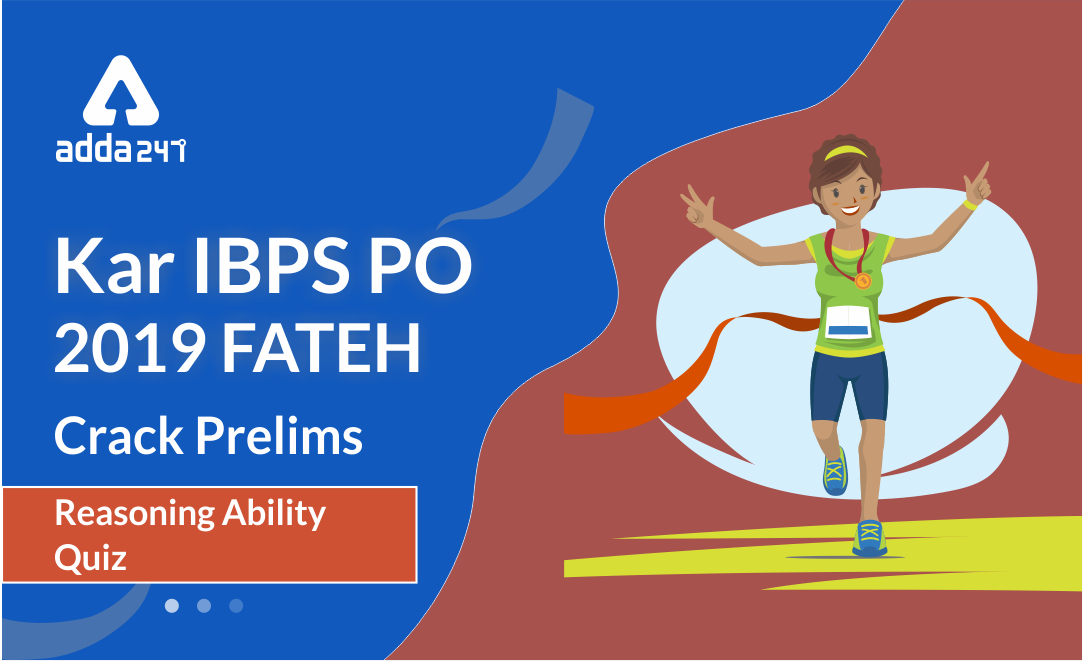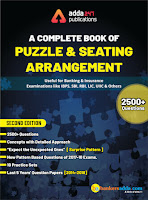The reasoning being the scoring part can enhance your performance as a whole. All you need to do is clear your basics and be aware of the syllabus of the particular exam you are preparing for. Study Notes for the topics like Puzzles, Coding-decoding, sitting arrangement, blood relations, and the list is long is provided on Adda247, so that you can make the preparation time fun by cracking the logic that runs the engine of a particular topic. Giving mocks and Quizzes on a regular basis will help you to decode the strategy. Also, the Study Plans go hand in hand with the exam preparations that will take place in the upcoming months. Like the IBPS PO Prelims are scheduled in the month of October and we already rolled the study plan ‘Kar IBPS PO 2019 FATAH’ for your aid. Under the same plan, here is the Quiz for Reasoning, to make sure that you don’t skip any important topic as well as be prepared to face any type of questions in the prelims. IBPS PO Reasoning Quiz of 15th September 2019 covers Miscellaneous Topics.
Directions (1-5): Study the information carefully and answer the questions given below:
Seven persons are going to participate in quiz contest in seven different months starting from March to September. D goes in the month which have even numbers of days. More than three persons are going in between D and C. Only two persons going in between F and C. E goes after G, who does not go in March. Three persons are going in between A and B. A does not go after C. More than one-month gap between A and F going for the quiz.
Q1. Who among the following person goes in April?
(a) E
(b) D
(c) A
(d) B
(e) None of these
Q2. Who among the following person are going immediate after the month in which E goes?
(a) B
(b) D
(c) G
(d) C
(e) None of these
Q3. Four of the following are alike in a certain way so form a group, which among the following does not belong to that group?
(a) E
(b) A
(c) F
(d) B
(e) None of these
Q4. Which of the following statement is true about C?
(a) C goes before F
(b) Only three persons go between C and G
(c) G goes just before C
(d) C goes in September
(e) Both (b) and (d)
Q5. How many persons are going in between G and B?
(a) Two
(b) One
(c) Three
(d) More than Three
(e) None
Solutions (1-5):

S1. Ans.(b)
S2. Ans.(d)
S3. Ans.(c)
S4. Ans.(e)
S5. Ans.(b)
Q6. How many pairs of letters are there in the word “POTENTIALLY” each of which have as many letters between them in the word as they have between them in the English alphabetical series?
(a) One
(b) Two
(c) Three
(d) Four
(e) More than Four
S6. Ans.(d)
Sol.

Q7. How many words can be formed from the 1st, 5th, 8th and 9th letter of a word ‘ASTONOMERS’ by using each letter once in the word?
(a) two
(b) one
(c) none
(d) three
(e) more than three
S7. Ans.(a)
Sol. Near, Earn
Q8. If all the letters in the word DELIGHT are arranged in alphabetical order from left to right in such a way that vowels are arranged first followed by consonants, then how many letters are there in between D and L after the arrangement?
(a) two
(b) one
(c) none
(d) three
(e) four
S8. Ans.(a)
Sol. Original word- DELIGHT
Obtained word- EIDGHLT
Q9. Payal is 21th from the left end of a row of 47 students and Neetu is 23th from the right end in the same row. How many students are there between them in the row?
(a) 4
(b) 1
(c) 3
(d) 5
(e) None of these
S9. Ans(c)
Sol.
Payal position from right end = (47+1-21) = 27
Students between them= (27-23-1) = 3
Q10. Kamalpreet ranked 13th from the top and 34th from the bottom in a class. How many students are there in the class?
(a) 47
(b) 46
(c) 39
(d) 49
(e) 45
S10. Ans(b)
Sol.
Number of students in the class= 13+34-1=46
Directions (11-15): In these questions, relationship between different elements is show in the statements. The statements are followed by conclusions. Study the conclusions based on the given statements and select the appropriate answer:
Q11.
Statements: Q>H≤D≥G>S=B≤L=I<Z
Conclusion: I: S<Z II: D≥B+
(a) If only conclusion I follows.
(b) If only conclusion II follows.
(c) If either conclusion I or II follows
(d) If neither conclusion I nor II follows.
(e) If both conclusions I and II follow.
S11. Ans(a)
Sol.
I: S<Z (True) II: D≥B(False)
Q12.
Statements: H=B≤C≤N>M=X≥P=L>D
Conclusion: I: H<N II: M≥ L
(a) If only conclusion I follows.
(b) If only conclusion II follows.
(c) If either conclusion I or II follows
(d) If neither conclusion I nor II follows.
(e) If both conclusions I and II follow.
S12. Ans(b)
Sol.
I: H<N (False) II: M≥ L(True)
Q13.
Statements: C>B<O<P=L>H=M≥S>X
Conclusion: I: O>S II: S≤O
(a) If only conclusion I follows.
(b) If only conclusion II follows.
(c) If either conclusion I or II follows
(d) If neither conclusion I nor II follows.
(e) If both conclusions I and II follow.
S13. Ans(d)
Sol.
I: O>S (False) II: S≤O(False)
Q14.
Statements: X>T<Y<B≥C>M=O≥P>Q
Conclusion: I: T<C II: Q<M
(a) If only conclusion I follows.
(b) If only conclusion II follows.
(c) If either conclusion I or II follows
(d) If neither conclusion I nor II follows.
(e) If both conclusions I and II follow.
S14. Ans(b)
Sol.
I: T<C(False) II: Q<M(True)
Q15.
Statements: S>W=N≤X≤K=J>C≥V
Conclusion: I: W=K II: W<J
(a) If only conclusion I follows.
(b) If only conclusion II follows.
(c) If either conclusion I or II follows
(d) If neither conclusion I nor II follows.
(e) If both conclusions I and II follow.
S15. Ans(c)
Sol.
I: W=K(False) II: W<J(False)
If you are preparing for Bank exams, then you can also check out a video for Reasoning below:





 GA Capsule for SBI Clerk Mains 2025, Dow...
GA Capsule for SBI Clerk Mains 2025, Dow...
 The Hindu Review October 2022: Download ...
The Hindu Review October 2022: Download ...
 Kamyab Divas Event: A Historic Success
Kamyab Divas Event: A Historic Success







